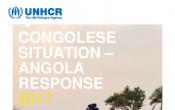Democratic Republic of the Congo Regional Office
Operation: Democratic Republic of the Congo Regional Office
Location
{"longitude":22,"latitude":-4,"zoom_level":5}
Latest update of camps and office locations 21 Nov 2016. By clicking on the icons on the map, additional information is displayed.
Key Figures
| 2016 end-year results | |
| 90% | of identified Central African refugee children with specific needs were assisted |
| 80% | of primary school-aged Burundian refugee children were enrolled in primary education |
| 79% | of primary school-aged Central African refugee children were enrolled in primary education |
| 68% | of Burundian refugee households received sufficient basic and domestic items |
| 3,400 | Congolese returnees had access to adequate shelters |
| 1,000 | emergency shelters were provided to CAR refugee households |
| 430 | monitoring missions were undertaken to IDP locations, followed by advocacy interventions |
| 2017 planning figures | |
| 287,380 | people of concern will receive production kits or materials for agriculture, livestock or fishery activities (250,000 internally displaced people and 37,380 refugees) |
| 45,400 | people of concern will be provided with transport in order to return to their homes |
| 23,200 | refugee children will be enrolled in primary school |
| 8,800 | refugees will receive transitional shelters |
| 750 | survivors of sexual and gender-based violence (SGBV) will receive medical assistance |
Latest Updates and Related Links
as of 18 September 2017
People of Concern
23%
Increase in
2016
2016
| 2016 | 3,321,847 |
| 2015 | 2,701,921 |
| 2014 | 3,619,785 |

[["Refugees",452887],["Asylum-seekers",3236],["IDPs",2232900],["Returned IDPs",619600],["Returned refugees",13224]]
Loading ...
Democratic Republic of the Congo Regional Office
< Back
2016
{"categories":[2012,2013,2014,2015,2016,2017],"budget":[157.672624547,196.62741826,196.1200685,207.82899884,209.71033616,234.31289883],"expenditure":[76.25272289,80.44026164,82.89793508,81.24654248,73.23818483,null]}
{"categories":[2012,2013,2014,2015,2016,2017],"p1":[84.337626717,84.29544165,71.90779198,91.41104086,103.12806996,136.7116264],"p2":[1.02275178,1.76370934,1.64748057,2.69677526,1.923405,1.94889796],"p3":[22.3166671,24.57256446,47.12909081,38.54665211,29.81920304,29.873246],"p4":[49.99557895,85.99570281,75.43570514,75.17453061,74.83965816,65.77912847]}
{"categories":[2012,2013,2014,2015,2016,2017],"p1":[43.22165176,48.3141246,50.09923907,57.35459999,58.9382084,null],"p2":[0.51723528,1.40268682,0.79246867,0.72133408,0.36397887,null],"p3":[8.24604447,12.22476921,16.65508797,10.2698795,3.24760875,null],"p4":[24.26779138,18.49868101,15.35113937,12.90072891,10.68838881,null]}
Loading ...
CHOOSE A YEAR
- 2014
- 2015
- 2016
- 2017
Working environment
The volatile security situation in the eastern Democratic Republic of the Congo (DRC) in late 2016 was further compounded by the delay of the Presidential elections and brought new challenges for the protection of civilians and increased tensions between communities.The Democratic Republic of the Congo remained among the world’s poorest countries in terms of gross national income per capita. In this socio-economic context, coupled with insecurity in some regions and problems of access due to lack of roads, providing protection and assistance to the growing number of refugees and IDPs in the country remained challenging.
Population trends
- The people of concern under UNHCR’s mandate increased by 16 per cent in 2016, reaching 3.3 million people in need.
- Refugee numbers grew from 383,000 in 2015 to 452,000 in 2016, mainly due to new arrivals from Burundi and South Sudan. A majority of the refugees come from the Central African Republic (CAR), Burundi, Rwanda and South Sudan.
- The number of internally displaced people (IDPs) increased from 1.6 million to 2.2 million people due to security incidents in the eastern DRC.
Achievements and impact
- All refugees living in camps and sites benefited from protection and multi-sectorial assistance
- The number of identified SGBV survivors decreased by 47 per cent as compared to 2015 but remained significant.
- 3,040 CAR refugees benefitted from cash-based interventions.
- 1,364 newly arrived South Sudanese households were provided with emergency shelters
Unmet needs
- Many refugees cannot attain socio-economic self-reliance, in the absence of sufficient self-reliance programme
- Only limited numbers of refugees from Burundi and the Central African Republic received transitional shelters to replace old emergency shelters made with plastic sheeting.
- Multi-sectoral and multi-level response to survivors of sexual and gender-based violence (SGBV), such as legal response and access to justice, was not provided
- UNHCR could not fully monitor the situation of refugees in some border locations and inlands, due to a lack of resources.
UNHCR’s operation in the Democratic Republic of the Congo (DRC) faces challenges that are linked to years of political instability, logistical problems, limited access, ongoing insecurity and limited state authority in certain areas.
In 2016, UNHCR will focus on the response to the needs of newly arrived refugees from the CAR. The Office has planned for the arrival of at least 25,000 CAR refugees in 2016, and a further 15,000 in 2017. Efforts will focus on the delivery of protection and basic assistance to refugees. UNHCR will also contribute to the assistance and protection of 1.7 million internally displaced people (IDPs).
As the lead agency for camp coordination and camp management (CCCM), UNHCR works with other clusters to improve cross-cutting services and assistance to IDPs. UNHCR will also continue to provide financial, technical and logistical support to the National Commission for Refugees (CNR).
The return and reintegration of Congolese refugees from neighbouring countries (i.e. Angola, Burundi, Rwanda, Uganda, the United Republic of Tanzania and Zambia) also constitute one of the key priorities for 2016.
Any funding shortfall would significantly affect protection services and basic assistance provided to refugees.






